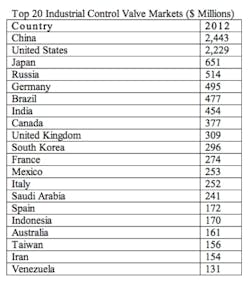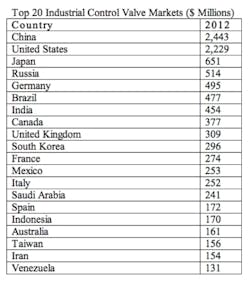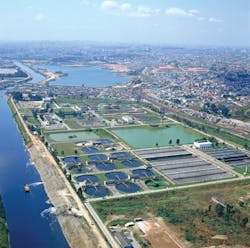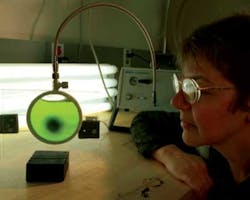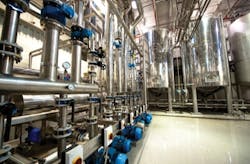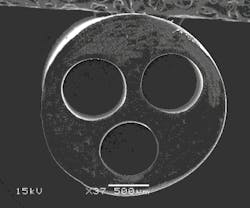Brazil's Water & Sanitation Trailblazer
São Paulo's state water sanitation company, Sabesp, is making huge investments to improve services in Brazil. Dilma Seli Pena became chief executive of the company earlier this year, previously serving in the state's government. Peter Howard Wertheim speaks exclusively to the CEO about current initiatives and reducing water losses.
Sabesp is one of the largest water and sanitation companies in the world. Such an acknowledgement is not only based on service numbers and the size of its operating network. This alone would be enough for this leading position. It's actually the firm's achievements in the technological, corporate and environmental areas that have led to this position.
Majority-owned by the State of São Paulo in Brazil, Sabesp is a mixed capital company, providing both water and wastewater services. Despite providing these services to millions of people in São Paulo, the firm is allowed to operate outside of the state and abroad, as well as to establish subsidiaries. Services include urban rainwater, drainage and management, urban cleaning and solid waste management, unrestricted operation of power generation, storage, conservation and energy activities.
Dilma Seli Pena has been the chief executive officer of Companhia de Saneamento Basico do Estado de Sao Paulo (Sabesp) since late January 2011. Prior to this, Pena served as assistant secretary for the Economics and Planning Secretariat of government of the State of São Paulo. Here she was responsible for the State Secretariat of Sanitation and Energy. Previously she served as director of sanitation of the Urban Policy Office, director of strategic investments of the Ministry of Planning and director of the National Water Agency of the Brazilian government.
The Sabesp CEO granted this exclusive interview to Water & Wastewater International (WWi) magazine to outline the major projects the company is involved in to help improve services to the population. "The focus of the company is a broader coverage of services until 2018," Pena tells WWi. "This is our target to guarantee gains in terms of quality of life, improvement in the health sector and preservation of the environment. Without a doubt our biggest challenge is to achieve better coverage in metropolitan São Paulo: an area comprising 39 municipalities densely populated with more than 20 million inhabitants. During the last four years a large share of the US$4.38 billion invested was directed to this area.
"This year we are investing US$1.27 billion. However, Sabesp has no intention of acting alone. Part of our policies include forging partnerships with other sanitation companies, private or public, which want to contribute to the expansion of services in the state of São Paulo."
Broad coverage
To provide geographical context, the state of São Paulo contains 645 municipalities and 41.7 million inhabitants. Sabesp operates in 364 of these municipalities, in which it supplies 23.7 million people directly with treated water, 20.1 million with wastewater collection and 14.7 million with wastewater treatment. Besides this 3.4 million people, who have their own systems, acquire treated water wholesale. Overall, 68% of the urban population of São Paulo is served by Sabesp, which operates in all hydrographic basins of the state. "Sabesp supplies 141 cities with 100% water and sewage treatment," the CEO goes on to say.
"To expand this pattern of excellence to all 364 cities, a total of 1.4 million new connections of water and 1.9 million sewage links are needed," says the CEO. "We estimate that in addition around 110,000 commercial points will be added, 10,000 industries and 6,000 public entities. Also, we expect an increase of sewage treatment of 180,000 companies, 17,000 industries and 8,000 public entities. These numbers indicate the vast challenge we face. But, recent experience encourages us: during the last four years an additional 900,000 people are being supplied with water from Sabesp, another 1.5 million now have access to sewage [wastewater collection] and 3.3 million now have treated wastewater."
Forecast investment is US$10.5 billion until 2019, to expand water and wastewater services in the 364 municipalities where Sabesp operates. This means an average of US$1.16 billion per year. This policy is already becoming a reality with considerable increase in investments in the last few years, including US$1.1 billion in 2008 and US$2.2 billion in 2009. This year more than US$1.3 billion is being invested. So where is this money going to come from, you may ask?
The company had net operational revenues of US$5.84 billion last year, with record net profits of US$1.03 billion. You could say it is indeed "financially solid". To reach the network coverage target Sabesp will use its own financial resources and national and international sources. At present, Sabesp has contracts with the Inter-American Development Bank (IDB) and Japan International Cooperation Agency (JICA).
The National Development Bank (BNDES) has released US$445 million. Furthermore, negotiations with JICA are underway for financing of US$413 million. And in June last year the governments of Brazil and Japan concluded the exchange of documents to authorise the release of this money. It is important to remember that for 2012 and 2013 Sabesp will also invest US$222 million from its own resources. The contract with JICA is expected to be signed in October.
"We need to diversify our sources of financing since the investments will be very high. Just this year we will invest US$1.3 billion," says Pena. "For this reason I am strongly in favor of diminishing the tax load over sanitation. Since 2003 federal taxes paid by Sabesp tripled. The main reason was the hike in Cofins, a contribution that finances social security. Such as health and social assistance. Cofins increased from 3% to 7.6%. During this period, Sabesp's gross operational revenues expanded by 22% in real terms.
"However, the tax load, discounting inflation increased by 97%! Just with PIS and Cofins taxes, last year Sabesp paid US$286 million to the Federal government. Adding this to other taxes, the figure reaches US$890 million. These taxes create serious problems to the sanitation sector," complains the CEO.
River restoration project
The Tietê Project began in 1992. This river is one of the most important rivers in Brazil and the main river in São Paulo state. Tietê is 1,100 km long and at the beginning crosses the metropolitan region of the city of São Paulo. In this region there are 20 million inhabitants, 50% of the population of São Paulo state. This is the heart of the Brazilian economy and there are many industries are positioned along the river.
"The Tietê project is divided into four phases," says Pena. "We are now in the third phase, which will end in 2015. The fourth phase should begin in 2013 so that in 2018 we reach universalisation. With the three first phases (US$2.65 billion) a total of 4,450 km of collecting networks will be installed, 1,135 km of interceptors and 740,000 new connections to residences. We have also three new wastewater facilities, as well as the expansion of two which are already operating."
The level of consumers serviced has grown substantially. For wastewater collection, the rate of 70% in 1992 is predicted to reach 87% in 2015. It is important to point out that this increase includes population growth: 15.3 million in 1992; 17.5 million in 2002; 18.8 million in 2008; 19.6 million in 2010 and a forecast of 20.1 million in 2015. Several programs are also underway to reduce pollution in the Billings dam. For example, the Tietê project is undergoing work to gather sewage in the São Bernardo do Campo and Ribeirão Pires cities, which are close to the reservoir. The second stage of the project, finished in 2008, focused greatly in this region. The Pinheiros Interceptation System was built, which gathers wastewater from the source and transports it 60 km up to the sewage treatment station of Barueri.
Pro-Billings
Another initiative, Pro-Billings, also aims to help with the recovery of water sources. It is forecasted that US$126 million will be invested in sanitation in the city of São Bernardo, with a 765,000 population, including important car manufacturers such as Volkswagen, Ford, Scania, and Mercedes Benz. The target set out states that by 2015, all wastewater from the basin of the Billings dam will be treated.
This project will directly benefit 250,000 inhabitants of the municipality. Indirectly the project will benefit five million inhabitants of Greater São Paulo supplied with the waters of the reservoir, since the project improves the quality of water of the source of waters and degraded areas. In terms of financing this project around US$63 million is set to be provided from the Japanese government via JICA. Sabesp is responsible for providing an equivalent amount of money.
"In the last four years Sabesp undertook six international credit operations: five already contracted and one being negotiated," states Sabesp's CEO. "For the Tietê project we signed a contract with the IDB for US$250 million in 2008 and US$600 million in 2010. With the World Bank we secured financing of US$100 million in 2009 for the program New Life/Water Sources, which invests in the recovery of dams."
Pena says that the firm secured a loan of US$63 million from JICA, contracted in 2010 for the Pro-Billings development. Furthermore, this year Sabesp secured US$200 million complimentary financing for the Clean Wave programme. Financing for the Program to Reduce Water Wastage is in the final stages and is expected to be signed in October for US$366 million. The CEO adds: "The next agreements are related to the fourth phase of the Tietê project, which will cost US$1.9 billion and will require at least three different sources. We have approached several international organizations: KFW (Germany), AFG (French Development Agency), CAF (Corporação Andina de Fomento), IFC (World Bank), and Morgan Stanley, besides important banks in Brazil such as: Santander, Itaú, Banco do Brasil, Bradesco, HSBC, and Caixa Economica."
Sabesp is in the consultation stage of the funding but the agreements must be signed in 2013, so that the fourth project of the Tietê can begin in time to assure broader coverage in 2018.
"To achieve this," Pena adds, "We also use partnerships with the private sector, besides financing and our own resources. We just delivered one of these projects in partnership; the expansion of the Water Treatment Station Taiaçupeba. This project increased water production by 432,000 m3/day at the cost of US$195 million. Part of the work for Clean Wave will be undertaken in a similar way. We are also preparing another large project in partnership to create a new supply system at an estimated cost of US$ 650 million. The Production System São Lourenço will make available an additional 466,560 m3/day of treated water for the Metropolitan Region of São Paulo."
Non-revenue water targets
Sabesp says that around 26% of water that is wasted does not arrive at the consumer. This includes water that is consumed but is not paid, either because of fraud or due to measuring equipment failures. Water lost in the network corresponds to two thirds of the total, while frauds are equivalent and incorrect measuring to one third.
The target is to reach 13% in 2019, reaching international standards. Today the figure is 26%. Main initiatives include a change of networks and branches, combating irregularities and substituting hydrometers. To reach this target, since 2009 Sabesp has been implementing the Corporative Program to Reduce Water Loss with domestic and international financing. Total investment for these initiatives will be US$2.7 billion, of which US$311 million has been invested to date.
CEO Dilma Pena is facing a huge challenge as the head of one of the largest water and sanitation companies in the world. Despite improvements in sanitation during the last decade, much remains to be done.
Speaking to WWi, sources at Sabesp say that Pena has deep understanding of the sanitation question and is a tough administrator, working hard to move the mammoth company to really universalise services.
More Water & WasteWater International Current Issue Articles
More Water & WasteWater International Archives Issue Articles
